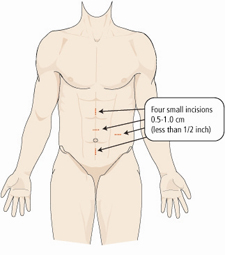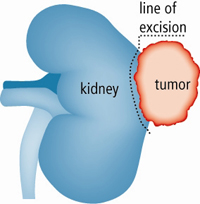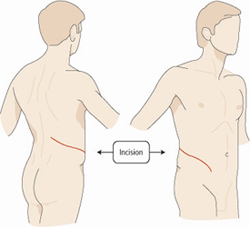Robotic Partial Nephrectomy
Understanding Robotic Partial Nephrectomy
Surgery
Surgery is generally the first line treatment for localized kidney cancer (cancer that has not spread). Removal of kidney tumors can be done using larger open incisions or through minimally invasive approaches such as laparoscopic or robotic surgery. These minimally invasive approaches give equal cancer control to that of open surgery and make for an easier recovery after surgery. At BIDMC, because of our extensive training and experience in these techniques, nearly all kidney cancer surgery is able to be performed laparoscopically or robotically. Over 95% of our partial nephrectomies in 2014 were performed robotically, a much higher rate than most other institutions. Additionally, greater than 95% of our radical nephrectomies in 2014 were performed using laparoscopy, sparing our patients a larger painful incision through the ribs and potentially weeks or months of recovery.
Partial nephrectomy is the removal of part of the kidney, usually because of a tumor, while sparing the remainder from damage or removal. It typically is performed if the renal tumor is less than 7-cm or the patient has only one kidney. Traditionally, this procedure has been performed as an open surgery through an 8-12 inch incision in the flank, requiring removal of one of the patient's ribs. (see figure 1a and 1b)
Robotic partial nephrectomy is a minimally invasive alternative, performed with thin, specialized instruments inserted through tiny incisions; the surgeon does not need to place his/her hand inside the abdomen. This results in a cancer cure rate equal to that of open surgery, but with far less pain and much quicker recovery.
Minimally invasive surgery is part of BIDMC's multidisciplinary approach to kidney cancer. To learn about the comprehensive treatment options available through our Renal Tumor Clinic, please click here.
The procedure
Robotic partial nephrectomy utilizes an operating telescope and thin, specialized instruments placed in the abdomen through 3-4 "keyhole" incisions, each 1cm. The blood supply to the kidney is temporarily interrupted to allow for tumor removal without excessive bleeding. The tumor is then carefully dissected free from the kidney, and the defect in the kidney is repaired using robotic suturing techniques. (See figure 2.) The tumor is placed inside a retrieval bag and removed through one of the incisions.
Advantages over open surgery
- Improved visualization of surgical field
- Less pain
- Shorter hospital stay
- Quicker recovery
- Better cosmetic result

- Lower transfusion rates
- Fewer infections
- Fewer wound hernias
Results
Cancer control
Robotic partial nephrectomy controls cancer equally as well as the traditional open procedure.
Blood loss
Typical blood loss is 200-300cc. Blood transfusions are extremely rare.
What to Expect after Surgery
Hospital stay
The typical hospital stay is 2 days.
Diet
Patients resume normal eating as they recover in the first day after surgery or soon thereafter.
Postoperative pain
Pain is managed immediately with an intravenous patient controlled analgesia pump, which is removed and replaced by pills the day after surgery. Upon discharge, pain pills are given for several days, after which over-the-counter acetaminophen or ibuprofen are usually all that is needed.

Urinary catheter
A urinary catheter is left in place for two days following the surgery and then removed.
Abdominal drain
A small drain is placed in the area of the kidney and is usually removed the second day after surgery.
Recovery
Most patients are able to return to full activity within 4-6 weeks compared with 8-12 weeks for open partial nephrectomy.
Follow-up
Patients will follow-up with their surgeon one month after the operation for a routine visit, then at 12 and 24 months with CT scans of the kidney to monitor for recurrence. Appointments can easily be conducted over the phone for patients living outside the Boston area, including international patients.

